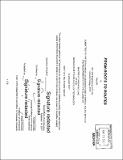From roots to routes
Author(s)
Ma, Xinyi, M. Arch. Massachusetts Institute of Technology
DownloadFull printable version (15.32Mb)
Other Contributors
Massachusetts Institute of Technology. Department of Architecture.
Advisor
Arindam Dutta.
Terms of use
Metadata
Show full item recordAbstract
Over the past two decades, more than 200 million people in China moved from rural to urban areas. These migrants fled the countryside, which is regarded as an economic wasteland in perpetual stagnation that is locked by feudal traditions and peasant values, to the largest cities. They sought to be connected to a modern China, one that is marked by a booming economy and pronounced popular culture. These rural- to-urban migrants have formed the largest peacetime inland migration in history. Mobility is a socially produced motion that often bears ideologies. It is associated with a desire for progress, freedom, and opportunity. The massive inland migration in China demonstrates the tremendous social force that aims to overcome the outdated social strata. However, as migrants move, limitations on mobility emerge. The Hukou, the household registration system in China, is an institutional framework that has entrenched the social strata for ages. Records of births, marriages, and moves identify each person with a place. As soon as migrants move from their designated origins, immobility appears: welfare exclusion, job inequity, urban transit inaccessibility, to name just a few. This thesis proposes to study this condition of mobility, immobility and estrangement in the district of Minhang, Shanghai, where 1.5 million migrants currently live and work. Scooter, an emerging fast and cheap personal vehicle, is the protagonist in this story of migrants. Linking closely to migrants' life, scooters are not only their primary means of transportation but also their means of production. Its mobility empowers migrants to move beyond their territory, while its unique scale and flexibility links to rich spatial possibilities.
Description
Thesis: M. Arch., Massachusetts Institute of Technology, Department of Architecture, 2017. Cataloged from PDF version of thesis. Includes bibliographical references (pages 78-79).
Date issued
2017Department
Massachusetts Institute of Technology. Department of ArchitecturePublisher
Massachusetts Institute of Technology
Keywords
Architecture.